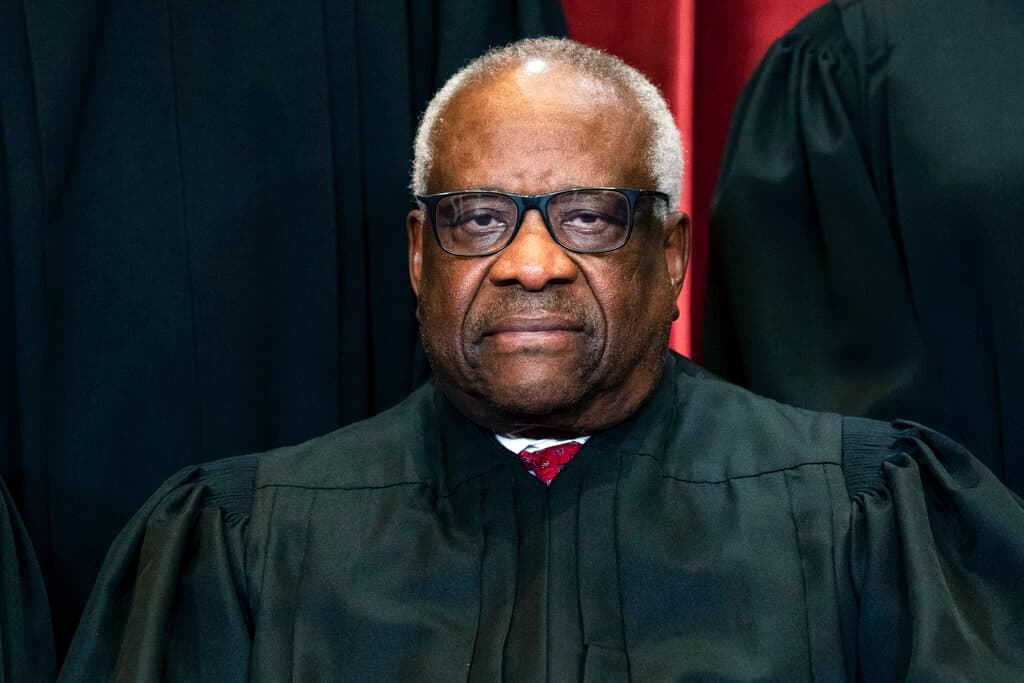Justice Thomas, in a Streak of Startling Opinions, Is Laying Down Markers for the Future
With the Nine charting a new constitutional course, the senior justice emerges as the one to watch to learn where the court is heading.

With the United States Supreme Court charting a new constitutional course, the longest-serving justice — Clarence Thomas — is emerging as the one to watch to learn not where the court is now, but where it is going.
In a number of startling dissents and concurrences, it is increasingly clear that Justice Thomas is writing not solely for this court but for those yet to come. The justice has long been the tip of the Nine’s conservative spear, but now finds himself signposting its next chapter.
This fresh prominence for Justice Thomas has come amid unprecedented criticism. His wife, Virginia, is a person of interest to the January 6 congressional committee. Calls for his impeachment have emanated from Representative Alexandra Ocasio-Cortez and a MoveOn petition festooned with more than 300,000 signatures.
The extent to which the justice — the oldest member of the high bench — has cast his eye to the horizons of American law was highlighted in the latest cache of high court decisions. In a dissent to the denial of certiorari in a libel case, Justice Thomas wrote: “I would grant certiorari in this case to revisit the ‘actual malice’ standard.”
That standard, articulated in the case that is known as New York Times Company v. Sullivan and was decided in 1964, held that to triumph in a defamation suit, a public figure must show that the outlet making the statement knew it was false or recklessly disregarded whether it was true or false.
Times v. Sullivan made it extremely difficult for a famous person in government or business to sue for libel. Yet Justice Thomas writes that “this case is one of many showing how New York Times and its progeny have allowed media organizations and interest groups “to cast false aspersions on public figures with near impunity.”’
Justice Thomas goes further to note that we have never even inquired whether “the First or Fourteenth Amendment, as originally understood, encompasses an actual-malice standard.” His colleagues this time declined Justice Thomas’s invitation to take a wrecking ball to “actual malice.” Next time, they might seize it.
The 14th Amendment, which Justice Thomas references in respect of “actual malice,” is the lodestar for his thinking in Dobbs v. Jackson Women’s Health, the decision that ended Roe v. Wade. While eliminating the constitutional right to an abortion, the majority reassures that “nothing in this opinion should be understood to cast doubt on precedents that do not concern abortion.”
That doubt is exactly what Justice Thomas surfaces in his concurrence when he urges that “in future cases, we should reconsider all of this Court’s substantive due process precedents, including Griswold, Lawrence, and Obergefell.” Those cases involve, respectively, birth control, same-sex relations, and same-sex marriage.
The justice’s concurrent remarks look like a program for washing away such landmarks. That reconsideration, should it come to pass, would be driven by Justice Thomas’s belief in a pernicious and “dangerous” atextuality of the “legal fiction” of substantive due process, or the notion that the 14th Amendment is a storehouse of implied rights just waiting for judicial discovery.
The Wall Street Journal editorial page, while noting that “substantive due process is a long-time preoccupation of Justice Thomas, and we respect him for it,” evinces skepticism that this preoccupation will in turn drive law, remarking that “no other Justice joined his opinion.” Not yet, at least.
It is not only the scribes at the Journal and Justice Samuel Alito’s majority opinion that seek to forestall Justice Thomas’s evocation of the end of substantive due process. Justice Brett Kavanaugh’s concurrence proceeds to “emphasize what the Court today states: Overruling Roe does not mean the overruling of those precedents, and does not threaten or cast doubt on those precedents.”
In all of Shakespeare, there is no lady who didst “protest too much” with more avidity than Justice Kavanaugh.
A case from 1995, Adarand Constructors Inc. v. Pena, might provide a preview for one slated to be heard this fall, Students for Fair Admissions v. Harvard. In the former, Justice Thomas joined the majority in holding that all racial classifications must pass strict scrutiny review, the highest of standards. The latter turns on affirmative action in higher education.
Yet in Adarand, Justice Thomas penned a separate concurrence, where he wrote that “as far as the Constitution is concerned, it is irrelevant whether a government’s racial classifications are drawn by those who wish to oppress a race or by those who have a sincere desire to help those thought to be disadvantaged.”
Discussing a federal program that gave contractors incentives to in turn hire minority-owned businesses, Justice Thomas added that “there can be no doubt that the paternalism that appears to lie at the heart of this program is at war with the principle of inherent equality that underlies and infuses our Constitution.”
In their brief seeking to end the use of race in college admissions, Students for Fair Admissions quote a line authored by Justice Thomas in another opinion, Fisher v. University of Texas, to the effect that “every time the government places citizens on racial registers and makes race relevant to the provision of burdens or benefits, it demeans us all.”
Should the Nine find against Harvard next year, it will once again have been Justice Thomas whose jurisprudence brought the future into focus. What’s emerging now is that Justice Thomas seems to have been laying down a series of buoys bobbing above constitutional lobster traps to be brought in after the coming storms.

